|
FIRE CONTRACTING "A DANGEROUS GAME"??SEPTEMBER 02 -- PORTLAND, OR: Oregon's contract firefighting industry has grown dramatically in the last few years, and some estimate that the state is home to more than half the fire contractors in the country. But oversight of the industry hasn't grown as rapidly as the business, and that worries some government officials.
Several recent vehicle accidents, and an overall rise in vehicle incidents over the last few years, have prompted more concern about the future of the contracting industry, according to an AP story in the Register-Guard. And the state has failed to adequately monitor contract firefighting, said John Venaglia, who oversees crew contracts for the National Interagency Fire Center in Boise.
"It's a dangerous game they're playing," he said. "It's going to result in problems, and it already has."
The number of crews has roughly quadrupled in five years, while U.S. Forest Service staffing has plummeted. Under Venaglia's system, 50 of 52 national crews trace their roots to Oregon. Another 298 crews are dispatched all over the West. And he says all but a few are from Oregon.
"We've become a source for the nation, but we don't have the resources to adequately deal with the growth," said Bill Lafferty, the Oregon Department of Forestry's fire program director. "We've got some rough spots, and most of those are in government's capacity to ride herd on the work force."
For years, industry leaders have pressed the state of Oregon, which is responsible for administering Pacific Northwest contracts for the federal firefighting agencies, to maintain better monitoring of contract crews. And ODF last year suspended 10 crews for a variety of problems. Five crews have been suspended this year, for problems from marijuana use to poor performance to sexual harassment.
Another recurring problem is competency in English; this year the state has written eight "letters of concern" to contract companies about language competency. The number of Spanish-speaking crews has grown tremendously in the last few years, and fireline inspectors say their efforts to enforce the language requirement are met with charges of racism. An AP story in the San Francisco Chronicle explained that a fire crew last year on a fire in southern Oregon was nearly overrun by fire when they failed to understand warnings shouted at them in English. "That's a dangerous situation," said Ed Daniels, training manager with ODF, who investigated the account.
It's estimated that Hispanics make up more than 60 percent of the contract crews in the Pacific Northwest -- and many of them can't speak English or understand it. The Pacific Northwest Wildfire Coordination Group has strengthened language requirements; on any 20-person crew, the boss and the three assistants must speak English fluently. And all fire communication on the radio must be in English.
Some employers refuse to hire firefighters who don't speak English; they say language barriers create avoidable dangers.
"Fires are spoken in English," said Rick Dice, president of the National Wildfire Suppression Association, a professional organization that includes 125 contracting members in Western States. Dice said the lack of English is usually synonymous with little experience on fires.
ODF this year has sent home six crews before they even started working because they didn't meet the English requirements.

AUSSIES AND KIWIS BACK IN MONTANASEPTEMBER 02 -- HAMILTON, MT: Nearly 50 fire overhead from Down Under arrived in Montana over the weekend, the third time in four years that reinforcements from Australia and New Zealand have helped out on U.S. fires. They arrived in Boise, according to the Ravalli Republic, last Wednesday and have been assigned to fires including the Cooney Ridge Fire, burning in three counties, most actively near Clinton.
The Scoop in New Zealand reported that their National Rural Fire Officer, Murray Dudfield, said the firefighters are all experienced in management and supervision. "At this moment more than 30 uncontained wildfires are blazing across the state of Montana burning over 120,000 hectares," he said. "They have caused hundreds of millions of dollars worth of damage and cover vast areas. The largest fire has so far destroyed almost 10,000 hectares."
The Age reported that the group incloudes 16 firefighters from New South Wales, comprising members of the Rural Fire Service, State Forests, National Parks and Wildlife Service, and the NSW Fire Brigade.
The New Zealanders left Auckland last week for the National Interagency Fire Center in Boise, and won't return for 35 days.
Imported firefighters worked on fires in Montana during the 2000 season, and worked on several Oregon fires last year. The personnel include strike team leaders, division supes, helicopter managers, and specialists in operations, planning, logistics, and infrared mapping.
The fire managers work here under an international agreement drafted during the 2000 fire season.

SCOTT NIEDERMAYER BRINGS STANLEY CUP HOME FOR FIREFIGHTERSSEPTEMBER 02 -- CRANBROOK, BC, CANADA: New Jersey Devils defenseman Scott Niedermayer showed up in his hometown on Saturday with the Stanley Cup -- as a morale booster for the hundreds of firefighters who've been fighting fire on his home turf.
"They are having some pretty long days, tough days," said Niedermayer, "so if this will put a smile for a minute that will be good. That's tough work they're doing, long days, so we owe them a lot of thanks for the work that they do."
Fire crews were thrilled, according to a story with nhl.com, to see both the Stanley Cup and Niedermayer, who was a key force in the hockey playoffs against Anaheim.
The Lamb Creek Fire southwest of Cranbrook has forced about 200 residents from their homes, and burned more than 100 square kilometers of forest -- nearly 25,000 acres. Aircraft have been dropping retardant and crews have been chasing spot fires and clearing powerlines. Niedermayer said it's unsettling watching the fire burn the area where he grew up. Hundreds of locals lined up in a hockey arena to have photos taken with their hometown hero and the Stanley Cup; Niedermeyer's mother asked him to take the cup to fire camp late Saturday evening to thank the exhausted firefighters.

CALIFORNIA FIRE FORCES 50 FIREFIGHTERS
TO DEPLOY SHELTERSAUGUST 29 -- MORGAN HILL, CA: About 50 firefighters on the Devil Fire in southeastern Alameda County deployed shelters early today in a flare-up that injured two people. At about 2 a.m., according to the Contra Costa Times, hand crews with the state Department of Corrections were working near a ridge when the fire flared up. They moved to a safety zone and deployed shelters. George Hoyt with CDF said two firefighters suffered minor burns; the rest returned to work after the incident.
According to the Morgan Hill Times, at least 25 fires were ignited in the Diablo Range east and northeast of Morgan Hill into Alameda and Stanislaus counties. The Devil Fire yesterday was at 487 acres with about 15 percent containment, the Hamilton Fire was at 462 acres with 50 percent containment, the 3,832-acre Jump Fire was 30 percent contained, the 60-acre Kincaid Fire was 40 percent contained, and the Annie Fire was 40 percent contained at 3,874 acres.
Strong afternoon winds and steep, inaccessible terrain were slowing containment efforts. The incident command post was established in Dublin, with 800 firefighters in base camp at Christmas Hill Park in Gilroy. The Annie Fire, burning off Highway 152 near Henry Coe Park, has been a major challenge.
"It's remote, the access is horrible, extreme," said Chris Morgan, fire prevention specialist for CDF. "The firefighters have had to walk quite a distance just to get to the fire. Our needs are crew and aircraft."
Jeff Harter, CDF division group supervisor, said when they got to the fire at 11 a.m. Wednesday, it was at 500 acres. By 4 p.m., the fire had quadrupled in size. Local residents said the Upper Quinto Canyon Creek area hadn't burned in several decades.
The Santa Clara Complex was at over 18,450 acres by this morning and was estimated at 50 percent containment. More than 2,300 firefighters are assigned. The worst of the fires in the complex is the Annie Fire, north of State Highway 152 and east of Henry W. Coe State Park near Morgan Hill.
"The winds are extremely changeable," said Hoyt. "It's really, really wicked wind in some of those areas."
About 55 homes and other buildings are threatened by the fires. According to an AP story in the Herald-Tribune, the grass fires burning in rural areas around the San Francisco Bay area have doubled in size to nearly 20,000 acres. The fires were ignited last Monday when a lightning storm -- unusual for this time of year -- rolled over the Bay Area.

ROLLOVER INJURES FIVE FIREFIGHTERSAUGUST 29 -- JOSEPH, OR: Five firefighters on the Lightning Complex near Hells Canyon were injured last night when their vehicle rolled from Dug Bar Road north of Imnaha. According to the Oregonian, three of the firefighters were transported to Wallowa Memorial Hospital in Enterprise with relatively minor injuries.
Jason Blodget and Rigo Perez were flown to Spokane by an Oregon Army National Guard helicopter; Blodget was in serious condition at Sacred Heart Hospital but there was no immediate word on Perez's condition. The other three firefighters -- David Konyndyk, Danny Popovici, and Colin Padden -- were at the hospital in Enterprise and were expected to be released yet today.
KATU-TV reported that the crew cab went off a 200-foot embankment and rolled over. The firefighters are employed by Strike Back, a contractor in Dayville. Strike Back's owner was headed to Wallowa County today to meet with the injured firefighters.
The Dug Bar Road is the only access on the Oregon side of the Snake River for almost 80 miles. It is a bumpy, steep, narrow, 30-mile dirt road that's been called the "Longest Dead-End Dirt Road" in Oregon.

MONTANA FIRE CREWS EXPECT MORE WINDAUGUST 28 -- HELENA, MT: Crews took advantage of light rain and cooler temperatures yesterday to regain ground lost the night before when strong winds pushed fires into forcing firefighters off the lines.
The Rathbone Fire north of Yellowstone jumped Highway 191 on Tuesday, growing to 3,100 acres and closing the highway between Bozeman and West Yellowstone, but the break in the weather yesterday allowed fire managers to re-open that route. Traffic was being escorted through part of the highway yesterday.
The Helena Independent Record reported that fires flared up again in Glacier National Park, closing 30 miles of the Middle Fork of the Flathead River; forecasts include hot temperatures, more wind, and little or no rain for the rest of the week.
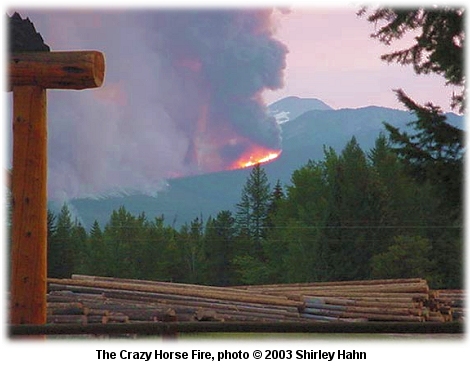
The Daily Inter Lake reported that fire bosses across the state share a common concern -- wind. Not the kind of sporadic wind that influences every fire -- they're worried about the kind of wind that can bend trees for days, winds that fit perfectly with fires lined up in east-west drainages. They are worried about the kind of winds that can turn a bad fire season into a catastrophe.
Active fires currently cover about 325,000 acres in Montana, but crews have thus far been spared the sort of winds that drove the infamous 1910 fires. Dave Bunnell, a 38-year fire veteran, says this is the time of year when the northern Rockies can experience a "Bermuda triangle of weirdness" when it comes to wind.
"We are set up," said Bunnell. "The last move required to have a repeat of these major fire events of the past is a major, long-term, sustained wind." Both Bunnell and Bob Mutch, a 50-year fire veteran, came out of retirement to help with the Northwest Montana Area Command group at the request of area commander Rex Mann.
They compiled a regional fire history, which was distributed to all incident commanders in the region. Mutch said they had six dry cold fronts in Yellowstone in 1988, and on August 20 that year the fires around Yellowstone grew by 152,000 acres. On August 29 and 30, the fires gained 172,000 acres. Between September 6 and 10, the fires gained a staggering 614,619 acres, an area that amounted to 36 percent of the 1.6 million acres burned around the park that summer.
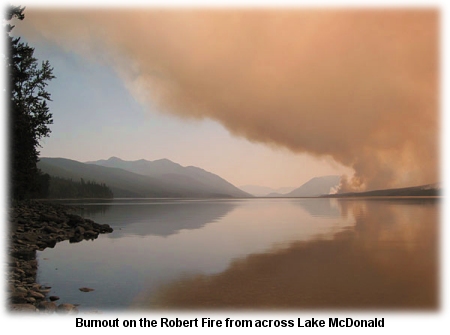
The benchmark for fires was the Big Blowup of 1910, which burned 3.5 million acres, with 75 percent of that acreage burning during one windy 36-hour period in August. When those fires were drenched by rain on the last day of August, they'd destroyed six towns in the region and killed 85 people -- including 78 firefighters.
Winds on Tuesday night pushed the Black Mountain 2 Fire near Missoula into a 200-acre run, and the Little Salmon Complex gained another 3,000 acres -- to a total of 38,500 acres.
The Great Falls Tribune reported that flare-ups were reported west of Missoula, near Lincoln, in Glacier National Park, and in the Bob Marshall Wilderness. Southwest of the Robert Fire, crews completed some crucial burnouts to protect the towns of Hungry Horse and Martin City from the 900-acre Beta Lake and Doris Ridge fires.
Rex Mann, area commander for the Blackfoot Lake Complex, Ball Creek, Wedge Canyon, Robert, Middle Fork Complex, Trapper Creek Complex, Crazy Horse, Rampage Complex, High and Little Salmon Creek Complex, said the forecast doesn't look good. "We are extremely concerned about the combination of severe weather conditions, changes in predicted weather, escalating fire behavior, and the large existing fires," he said.

WHAT'S NEXT? LOCUSTS?AUGUST 27 -- TUCSON, AZ: Homes along the Cañada del Oro Wash and parts of Sabino Canyon could be threatened by floods for years to come as land laid bare by the Aspen Fire sheds rainfall, and though the volume of ash washing down from the burned watershed will diminish, it could take years for the vegetation in the burn to recover.
Monsoonal storms in southern Arizona are now putting people at risk of drowning in the desert. The Arizona Daily Star reported that flooding has already claimed the life of publisher Jim Huntington, who was swept nearly a mile from his home near Oracle on August 15 after a wall of water washed down from the Santa Catalina Mountains.
On Monday night, almost two inches of rain fell on Mount Lemmon in less than an hour. Some forty homes were evacuated; another storm hit Tuesday afternoon, toppling powerlines and trapping six vehicles under live wires. The Cañada del Oro's flow was nearly 7,000 cubic feet per second, four times the 1993 flooding level.
According to the Tucson Citizen, the V&L Nursery suffered $80,000 worth of damage. The owner, Vaughn Hoffmeister, said the floodwaters pushed him about 100 feet when he tried to shut his gate. "This whole place was a river," he said. "It was ready to come into the house."
In a report by KGUN-TV, residents described the flooding after sheriff's deputies called for evacuations. "We have seen a lot of our friends' property going down the road," said Jennifer Canizales. "Water heaters and things like that. They're afraid. There's nothing up there to stop it from coming down here."
The Aspen Fire was one of three major wildfires in the Catalinas in the last two years that have burned 183 square miles above the Tucson metro area. The three largest fires this year in Arizona were the Aspen Fire at 84,750 acres, the 24,714-acre Kinishba Fire, and the 18,575-acre Blue River Complex, which included the Thomas and Steeple and Largo fires on the Apache-Sitgreaves National Forest.
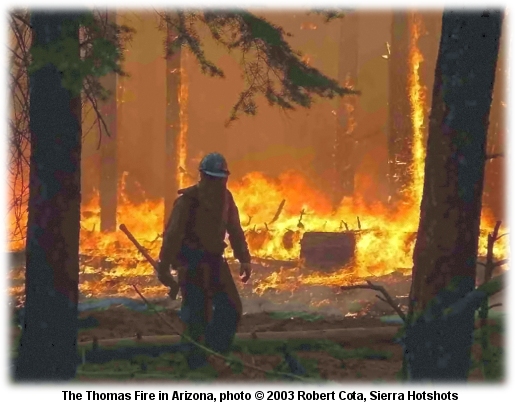
The steep and rocky terrain above Tucson -- like many areas of the Southwest desert -- quickly casts off water under normal conditions, but the fires changed conditions for the worse. Before the fires, rain was intercepted by the trees, shrubs, and forest duff. But the rain in the fire areas now falls on bare and blackened earth, where intense heat has made the ground water-repellent, dramatically increasing the likelihood of slides and flash flooding.
In northern Arizona, the National Weather Service on Monday issued a hazardous weather outlook through Thursday for Yavapai, Apache, Coconino, northern Gila, and Navajo counties.

NORTHEAST OREGON FIRES UPDATEAUGUST 26 -- LA GRANDE, OR: Though most of the fires burning in northeast Oregon have been contained, the Lightning Complex on the Wallowa-Whitman still includes several uncontained fires smoldering in heavy timber.
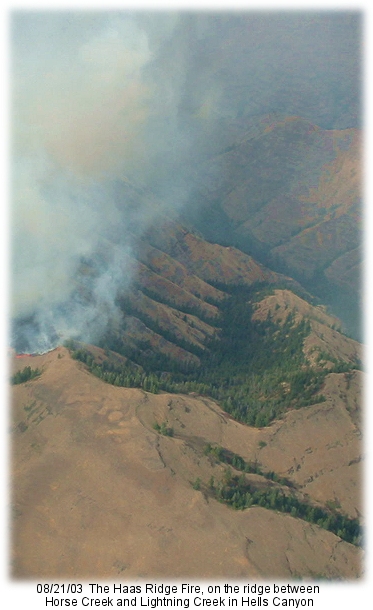 Morcom's Type 2 team is headquartered at the Joseph Rodeo Grounds, with 11 crews, five engines, five helicopters, six water tenders, and a total of 430 personnel. The complex includes the Grouse Creek, Haas Ridge, Butcherknife, and Two Corral fires. Morcom's Type 2 team is headquartered at the Joseph Rodeo Grounds, with 11 crews, five engines, five helicopters, six water tenders, and a total of 430 personnel. The complex includes the Grouse Creek, Haas Ridge, Butcherknife, and Two Corral fires.
The Haas Ridge Fire, on the ridge between Horse Creek and Lightning Creek in the Hells Canyon National Recreation Area, is now at 5,128 acres with 60 percent containment. The Two Corral Fire, two miles west of the Snake River near Two Corral Creek in the Wilderness, is 25 percent contained at 9,961 acres.
The Wallowa County Chieftain reported that the Two Corral is the largest in the complex; it's burned through mostly grass down to the Snake River, and is about two miles across. Containment is predicted for this weekend.
Andy White with the Oregon Department of Forestry said the success of the suppression effort is apparent in the fast containment of the Grouse Creek Fire, which had a good chance of spreading to private property. He said the intensive early strike effort kept it small.
"It was a tough save," he said, "a good save. It was a model of what you can do when you put agencies together. It kept the fire from getting on private lands; we could have been chasing a 2,000-acre fire."
The Two Corral Fire burned the historic Salt Creek Cabin Thursday night, despite protective fireline constructed around it. Structure protection is in place for a number of other sites in the HCNRA, incuding the Temperance Creek cabin. Fire burned to within a quarter-mile of the cabin.
Friday's heavy rain slowed fire activity on the Hazel Mountain Fire near Green Lake. The fire is burning in rocky terrain and is being managed under Wildland Fire Use. While all fires outside the Eagle Cap Wilderness are being suppressed, this fire is in monitor status.
A total of 16,436 acres were burned in the four fires of the Lightning Complex as of today, a week after they were started by lightning. Costs are estimated at $1,468,156 and full containment is expected by the end of August. More information is available from the Northeast Oregon Interagency Fire Center.

8 OREGON FIREFIGHTERS IDENTIFIEDAUGUST 25 -- ROSEBURG, OR: Six men from Douglas County and two others from Portland were identified today as the eight firefighters killed in a head-on collision with a semitrailer truck near Vale yesterday. Killed were Ricardo "Ricky" Ruiz, 19, of Roseburg; Mark Ransdell, 23, of Myrtle Creek; Jesse James, 22, of Roseburg; David Hammer, 38, of Portland; Leland Price Jr., 27, of Roseburg; Paul Gibson, 25, of Myrtle Creek; Richard B. Moore II, 21, of Portland and Jeff Hengel, 21, of Roseburg.
The two occupants of the semitrailer truck -- Stephen Anthony Nicholson, 37, and Joy L. Nicholson, 39, both of Ogden, Utah -- survived the crash, according to a Seattle Times report. They were taken to a hospital with dislocations and burns.
The eight firefighters had been assigned to the South Fork Fire in Idaho and were on their way home.
"I extend my wholehearted sorrow and sympathy to the families who lost their sons today," said Robert Krueger, president of First Strike Environmental, the company that employed the firefighters. "These were all fine young men who had worked together for two years. They were closer than most, and the hole they leave is enormous."
Roseburg Mayor Larry Rich said he was in shock. "It's one of those moments when it's unbelievable, that there's no way this could have happened," he said.
The van was traveling with another company van and a truck. Both those vehicles were about six miles ahead and did not see the crash. They came back to discover it after they lost radio contact with the van.

EIGHT OREGON FIREFIGHTERS KILLED ON HIGHWAYAUGUST 24 -- VALE, OR: A van with firefighters on their way home from a fire on the Boise National Forest collided late this morning near Vale, Oregon, with a semitrailer truck, killing eight crewmembers who worked for First Strike Environmental, a fire contractor out of Roseburg.
Malheur County Undersheriff Brian Wolfe said the van crossed a double-yellow line on a highway curve before it collided with the truck. Sheriff Andy Bentz said both people in the truck were injured and taken to a hospital in Ontario, Oregon.
Six of the firefighters were from Douglas County and two were from the Portland area. According to AP reports, the firefighters were traveling with another van that was ahead of them on the road. They were returning from the South Fork Fire on the Boise National Forest northeast of Cascade, Idaho.
The San Francisco Chronicle reported that the passengers in the lead vehicle did not see the crash. They drove back on the road after losing radio contact with the other van.

1994 PLAN CREDITED FOR CARNATION CONTAINMENTAUGUST 24 -- CARNATION, WA: Fifty engines and more than 170 firefighters from 20 different jurisdictions responded to a fire that threatened hundreds of homes here; though the fire reached only 30 acres, local fire officials say the same fire ten years ago would have been far more dangerous.
Before the state of Washington adopted its Fire Services Resource Mobilization Plan, resources would have been deployed more slowly, and the damage would have been much worse, according to Fire Chief Lee Soptich of Eastside Fire & Rescue. The plan was adopted in 1994 after a series of 92 fires -- the Spokane Firestorm -- killed a firefighter and destroyed 114 homes.
The King County Journal reported that state and local agencies developed the plan to unfold like a military operation; it divides fire response into tiers, with the local fire department as the first tier. Mutual aid with surrounding fire departments comes next, followed by 11 more zones in a four-county region, followed by nine more regions, followed by the state.
Initial attack on Thursday's incident saw the fire and called for reinforcements. They realized they would be overwhelmed and called for mutual aid. Then units from a neighboring zone were mobilized.
"Once they depleted those resources," said Soptich, "the Office of Emergency Management in King County got more units from the other two zones, Seattle and South King County."
That all occurred within the first half-hour.
"They were about half a step ahead by calling other places, lining up resources," said Soptich. "The system worked just beautifully."
Just two weeks ago, Eastside Fire & Rescue finished a structure protection plan for three communities. It specifies locations of water resources, escape routes, and other details.
The fire, according to King County Fire District, was started by fireworks. Remnants of a "ground bloomer," according to KOMO-TV, were found at the origin of the fire.

OREGON FIRES DOUBLE IN SIZE OVERNIGHTAUGUST 23 -- SISTERS, OR: Though cooler cloudy weather and light showers will help with fires in central Oregon, two wildfires near here doubled in size Thursday night to nearly 25,000 acres. Oregon Gov. Ted Kulongoski declared a state of emergency to bring on National Guard troops and heavy helicopters from the Air National Guard.
The B&B; Complex on the Deschutes National Forest comprises the Booth Fire and the Bear Butte Fire. Managed by Anderson's Type 1 team, the fires are about 14 miles west of Sisters in timber and heavy ground fuels. The community of Camp Sherman was evacuated, and structure protection is in place for 1,000 homes and 200 commercial
properties.
The Statesman-Journal reported that locals are worried about the closure of Highway 20 -- the town's lifeline linking the area to the west side of the state -- and the idea that Sisters is a fire-prone town best avoided during fire season.
"It's bloody awful," said Logan Godsiff, an employee at Eurosports, a mountain bike and outdoors store. "It happened the last time. When they close the highway, nobody bothers to come in."
Warm dry weather is expected through Tuesday, so the benefits of the tenth of an inch of rain the area saw will be short-lived. "It's going to slow down the spread and knock the heck out of the spotting potential," said Lori Hammer, fire information officer. "But this isn't going to touch the heavy fuels." Firefighters said the fire behavior Thursday was more severe than they had seen on other fires this summer.
The Booth Fire was estimated last night at more than 20,000 acres with zero percent containment, and the Bear Butte Fire is at about 4,000 acres. The Bend Bulletin reported that the Booth Fire burned 11 structures and two vehicles at the Round Lake Christian Camp, according to aerial recon. But Incident Commander Bob Anderson said they've been unable to confirm this because fire activity has been too intense to allow firefighter entry into the area.

10,000 EVACUATED IN BRITISH COLUMBIAAUGUST 22 -- KELOWNA, BC, CANADA: A fast-moving fire approaching the suburbs of Kelowna in southern British Columbia has forced the evacuation of 10,000 people in Okanagan Mountain Park since yesterday, when the fire jumped a firebreak near a residential area.
Reuters reported that emergency officials in Canada's westernmost province said it was their "worst-case scenario" when a 32,000-acre fire burning south of the city jumped a containment line and burned into a neighborhood of new and expensive homes last night. Local news reports said that as many as 20 homes may have been damaged or destroyed by the flames.
Winds were light this morning, but residents were worried by forecasts that called for winds to pick up later in the day with the possibility of thunderstorms.
Evacuees were being directed last night to two emergency reception centers set up in downtown Kelowna, a city of about 100,000.
A report in the San Francisco Chronicle said 110 firefighters and 11 helicopters were working on the fire, with 50 dozers trying to cut a line around the perimeter. The Okanagan Mountain park blaze is one of a half-dozen major fires burning in southern British Columbia. More than 3,000 firefighters, including hundreds of Canadian soldiers, are assigned. The British Columbia government on August 2 declared a state of emergency and issued a travel advisory asking people to avoid the southern British Columbia backcountry.

U.S. FIRE PUTS CANADIANS ON EVACUATION WARNINGAUGUST 19 -- DANVILLE, WA: The Togo Mountain Fire on the Colville National Forest has grown to over 4,000 acres, and has residents of over 60 homes just north of the border on evacuation alert.
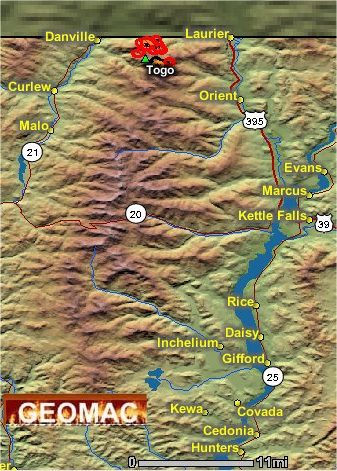 A Washington incident management team is assigned to the fire, which is burning in heavy timber just east of Danville. The fire is less than a mile from the Canadian border and headed north; a contingency line is being built on the Canadian side, and the British Columbia Forest Service is helping to put in a helicopter base in Grand Forks, about five miles north of the fire. A Washington incident management team is assigned to the fire, which is burning in heavy timber just east of Danville. The fire is less than a mile from the Canadian border and headed north; a contingency line is being built on the Canadian side, and the British Columbia Forest Service is helping to put in a helicopter base in Grand Forks, about five miles north of the fire.
The Seattle Post-Intelligencer reported that the fire was ignited by lightning. More than 500 firefighters were on the fire, which was just 5 percent contained.
Elsewhere in British Columbia, at least 200 people near Barriere were ordered to evacuate last night when their homes were threatened by the McLure-Barriere Fire, which had earlier forced thousands from their homes. Residents were told to head to Kamloops.
A canada.com report noted that about 500 people were evacuated because of another fire east of Kamloops. The McGillivray Fire that started Saturday has left a blanket of smoke over the town of Chase, and covers about 2,000 hectares [4,950 acres]. It has destroyed several cabins at Neskonlith Lake, and if it jumps the South Thompson River, it could threaten another 3,000 residents.

FATAL HELICOPTER CRASH IN BRITISH COLUMBIAAUGUST 19 -- KAMLOOPS, BC, CANADA: A pilot died when his helicopter went down Sunday about 80 kilometres (50 miles) east of 100 Mile House. The pilot, from Mission, was working the Bonaparte Lake Fire north of Kamloops. The Bell 205 helicopter was owned by Gemini Helicopters of Grande Prairie, Alberta.
A report by CBC News said the crash occurred shortly after takeoff near the fire. Witnesses told investigators that the pilot had just left a staging area with a long-line bucket.
The helicopter banked and attempted to return to the staging area before it crashed.

RESEARCHERS TO DEMONSTRATE WILDFIRE SENSOR TOMORROWAUGUST 18 -- ROCHESTER, NY: Scientists at the Rochester Institute of Technology will demonstrate their new wildfire-detection sensor research tomorrow for the U.S. Forest Service. The Rochester Business Journal reported that the Wildfire Airborne Sensor Program can identify and locate wildfires as small as 8 inches in diameter from an altitude of 10,000 feet.
Researchers Donald McKeown and Michael Richardson built the prototype as part of a $1.4 million program. Their sensor is mounted in a modified Piper Aztec aircraft; the system uses four infrared and high-resolution mapping cameras to take a series of images. The sensor system could detect fires with a low rate of false alarms even under bright sunlight.
Phase two of the project will add software to assemble the image with digital mapping. Tomorrow's test is scheduled for 10:30 a.m. (EDT) on West Avenue in Spencerport.

NEVADA YOUTH CREWS OFF THE LINESAUGUST 18 -- RENO, NV: Safety and liability concerns have prompted federal and state agencies to suspend the use of Nevada's youth crews on firelines. The Reno Gazette-Journal reported that they can still work at non-hazardous duty off the lines.
"These crews are a valuable resource, and we will continue to use youth crews nationwide in less hazardous positions in support of fire suppression," said Alice Forbes, Forest Service Assistant Director for operations at NIFC.
Three 20-person crews operated by Youth Centers in Nevada are affected. The National Wildfire Coordinating Group is studying the risks of using youth crews on fires, according to BLM Nevada State Director Bob Abbey. "The Nevada youth fire crews have made an enormous contribution to firefighting in Nevada and the nation in the past 43 years," said Abbey. "This action is no way reflects upon the safety record or capabilities of these youth."
Nevada State Forester Steve Robinson said the federal government is unsure of its legal position on youth crews; earlier this month, officials at NIFC issued a nationwide directive prohibiting those under 18 from hazardous duties during fires on federal lands. Federal law says 18 is the minimum age for hazardous duty, but state laws vary.

COLORADO GIRLS RAISE $5000 FOR PILOT'S SONAUGUST 18 -- ESTES PARK, CO: Ricky Lee Schwartz Jr. is only 9 months old, but he has a $5,000 college fund as of this weekend. Eight middle-school girls from Estes Park began collecting money for his college fund last summer shortly after his father, pilot Rick Schwartz, died on a fire in Colorado. He and fellow pilot Milt Stollack of California were killed when their tanker crashed on July 18 last year.
The Billings Gazette reported that the girls presented the money to Ricky and his mother Liz over the weekend. In an outfit proclaiming him "Junior Flyer," Ricky giggled and posed for photos.
Liz wants Ricky to grow up knowing about his father's passion for flying. "I want to be able to give him a sense of who his dad was," she said.
A photo tribute to Rick Schwartz is online at wildfirenews.com/schwartz

FIREFIGHTERS PULLED BACK AND RESIDENTS BAIL OUT AS MONTANA FIRES BLOW OUTAUGUST 17 -- MISSOULA, MT: Winds up to 55 mph blew the Black Mountain Fire west of Missoula into an inferno yesterday afternoon, chasing families from their homes as trees exploded on the hillsides and the fire threw brands and rained down ash for miles.
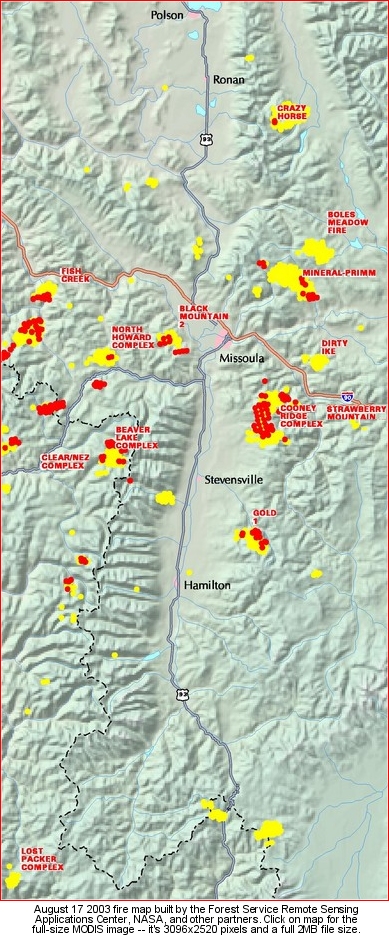 Smoke plumes and walls of fire billowed up from the hillsides, and a voluntary evacuation order for three homes soon became a mandatory evacuation of every home in O'Brien Creek, Triple Creek, Cedar Ridge, and Lyon Creek - 131 homes within reach of the advancing fire. Smoke plumes and walls of fire billowed up from the hillsides, and a voluntary evacuation order for three homes soon became a mandatory evacuation of every home in O'Brien Creek, Triple Creek, Cedar Ridge, and Lyon Creek - 131 homes within reach of the advancing fire.
The Missoulian reported that gale-force winds blew from the west, then the northeast, and then seemingly in circles. Fire bosses called for helicopter support, but the winds were too much. "This is too hot, too big," one pilot radioed. "There is nothing I can do."
Over the next three hours, the Black Mountain Fire burned more than 3,000 acres, throwing firebrands a quarter mile ahead of itself, igniting dozens of spot fires.
As the winds picked up and the fire took off early in the afternoon, crew bosses radioed firefighters to abandon their positions. The fire jumped across O'Brien Creek, but the wind and smoke were too much for even the heavy helicopters.
"Move your crews to the safety zones," came the order. "Everybody needs to be off the line." By 3:30 p.m., the last firefighters were safely out of Haggerty Gulch. Apache firefighters from Arizona said they were chased by flames 300 feet high.
"Fighting fire is never a fair fight," said Incident Commander Mike Dietrich. "You've got to kick it when it's down, because you know that's what it will do to you."
A Red Flag Warning was issued for gusty winds, hot temperatures, low relative humidity, and thunderstorms in southcentral and southeast Montana. An upper-level low pressure area will move into western Wyoming today; this trough will eventually be absorbed into another low across the four corners area, and will then move eastward through the Plains. Moisture and instability ahead and north of the system will cause
thunderstorms today from southwest to northeast Montana, through eastern parts of the Great Basin, and over the Southwest. Some dry storms in Montana are expected.
The Missoulian has a summary list of the major fires in Montana.


King Radio Clamshell Battery Packs
FROM: National Wildfire Coordinating Group
REPLY TO: [email protected]
DATE: 08/14/2003
From: James Reim, Assistant Safety Manager, Pacific Northwest Region
Recently we have received reports of the hazard of overheating alkaline batteries in clamshell radio packs. In one instance, three batteries exploded and sent out a mist of the corrosive material contained inside the batteries; contacts inside the pack melted from the heat of the batteries. In addition to the potential for injury resulting from such explosion, users of these radios could lose the ability to communicate in an emergency.
The problem results from use of clamshells, which were designed for older radios that needed 10 AA cells, in newer radio models. This is a common practice because many radio users prefer the replaceable AA batteries, which are convenient in the field. Ni-cad batteries have better operational characteristics, but they are not easily recharged and maintained during field operations. When adapted for new radios, the older packs use 9 AA batteries and a metal clip in the 10th battery space. In the old-style clamshells with the metal insert, the metal insert can create a circuit within the clamshell, causing it to rapidly overheat. Newer packs come with a spacer already installed. The spacer in the newer packs is not totally metal or is metal with a protective coating.
Supervisors should ensure that employees are provided with radios that have battery packs that are designed for, and are compatible with, the models in use. Where it is not feasible to immediately replace older design battery packs that are used on new radios, supervisors should ensure that the users are trained to properly install the batteries, to check the units for defects, recognize problems before a hazardous condition develops, and to correct them. Users should also be trained to understand the nature of hazards associated with damaged batteries, i.e. corrosive properties, and in use of appropriate protective measures, e.g. protective gloves and safety glasses, when handling them.
Please contact your unit radio technician for assistance. If there are questions about this safety alert, contact either John Murphy, R6 IRM at (541)278-6468 or James Reim, R6 Assistant Safety Manager at (541)517-3698.

RESOURCES STRETCHED, FIRES GROWINGAUGUST 14 -- BILLINGS, MT: Firefighting resources are stretched so thin now that key personnel and aircraft needed to fight a fire near Nye won't be available for days. Officials are requesting even more help than they normally would for a 40-acre fire, and they've ordered a Type 1 team.
Beartooth District Ranger Terry Jones told the Billings Gazette that the Cathedral Peak Fire in the Absaroka Beartooth Wilderness Area is burning in heavy lodgepole, and conditions there make it a threat.
"We're real worried about this fire," said Jones. "We put in an order for a Type 1 incident command team, but we're probably not going to get one for several days."
The fire is in steep country, where ground crews don't have access. And air support is busy on other fires -- primarily those where homes are threatened.
Wilderness fires just aren't a priority right now.
"To put people in there would be way too dangerous," Jones said. "Just to get up the steep slopes ... it would be dangerous just walking in to it. The only choice we really have is to use aerial support, and if we can't get those resources, we're pretty much stuck watching and waiting."
Jones said the Forest Service will fly over the fire, and he hoped that airtankers or helicopters might be available from other fires.
The potential is there for the Cathedral Peak Fire to get really big. "It's not going to go west very far or to the northwest far," he said, "but it has continuous fuel north and northeast, and the fuel is heavy all the way. There are a few ridges with rock, but it would go right over that."
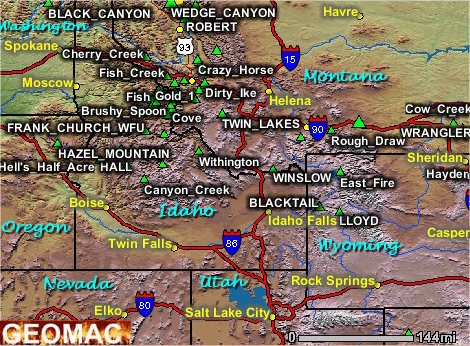
The Missoulian reported that more than a dozen fires have been combined into one complex called the Boles Meadow/Rattlesnake Complex. "We are so short-staffed and there's so much fire," said Virginia Gibbons, information officer. "We haven't even mapped some of the areas." On Sunday, the fire ran in almost every direction; 80 percent of the perimeter was active. "It was running northwest, then northeast, then to the southeast," said Seeley Lake District Ranger Tim Love. "People in Seeley Lake were hitting the panic button. There was ash falling on town, and it was so smoky you couldn't tell where the fire was, or how fast it was moving."
By Tuesday night, the Boles Meadow Fire had burned about 4,000 acres southwest of Placid Lake. "It's not an easy fire," Love said. "It's in some thick timber, so there is lots of fuel. We've got a long ways to go with this one."
Three new fires were spotted on the Lolo Tuesday, according to information officer Sharon Sweeney. "Since this siege began, we've had about 150 fires on the Lolo. She said incoming teams are warned about the very aggressive fire behavior. "Our largest fuels out in the woods, the big logs, are drier than kiln-dried lumber," she said. "They are at 9 percent moisture. So we're telling teams to stay behind the fires and build good, solid lines."

FOREST SERVICE OUT OF MONEY,
RAIDING NON-FIRE BUDGETSAUGUST 12 -- WASHINGTON, DC: As the West is pulling out all the stops again for another big fire season, the Forest Service has yet again exceeded its firefighting budget. Yesterday, 366 new fires were reported across the country, and very high to extreme fire indices were reported in Alaska, Arizona, California, Colorado, Hawaii, Idaho, Montana, Nevada, New Mexico, Oklahoma, Oregon, South Dakota, Texas, Utah, Washington and Wyoming.
But the Forest Service has already depleted its fire suppression funding for this fiscal year, and is once again raiding other non-fire budgets to pay for firefighting. Total suppression costs this year are estimated to reach $772 million, but the agency's appropriated fire funds run out at $418 million. So they plan to raid $420 million from other accounts to pay for it.
Sue Froeschle with the White River National Forest in Colorado said running out of money won't affect firefighting efforts; the Glenwood Springs Post-Independent reported that local USFS officials haven't found out yet how the budgetary shortfall will be addressed.
"The Washington office will make the determination as to where the dollars will be transferred from," said Froeschle.
A report by the Arizona Republic noted that the Forest Service on Friday transferred $66 million from other programs into its fire suppression account. That money came from funds budgeted for thinning and fuels reduction projects -- the first of several phases the agency will use to keep aircraft in the air and crews fighting fire on the ground.
The Forest Service likes to remind its customers that the agency mission is "caring for the land and serving people." A lot of that land-caring mission, though, is now taking a back seat to fire suppression, with budgeted funds for everything from archaeology to fisheries to wildlife to research being frozen and then transferred to the fire program, until or unless Congress approves requested emergency funds for fire -- and that doesn't appear likely any time soon.
"Continuing to fight wildland fire safely and efficiently is an integral part of that mission and the agency's top priority," according to Washington Office documents distributed yesterday. "Violating the Anti-deficiency Act is not an option. The Anti-Deficiency Act prohibits federal agencies from spending more money than has been authorized by Congress."
Congress has refused to approve needed increases in this year's fire budget -- a supplemental funding bill that would have provided $235 million for fire was not passed. Congress does, though, grant authority to the Secretary of Agriculture to use all agency funds available for fire suppression. Budgets for fish and wildlife and recreation and other non-fire programs can therefore be raided.
Funds that are transferred from non-fire accounts are -- usually -- reimbursed later. The agency says it's working with the Administration and Congress to assure that funds will be restored. That's not much comfort, though, to university researchers who have partnership agreements with the agency, or to the non-profit organizations with agreements in place with the agency, or non-emergency programs that both "care for the land and serve the people" later on when funding's restored.
In the Forest Service's northern region, the current national focus of firefighting, regional budget officers learned yesterday about the $66 million transfer. The Billings Gazette reported that $40 million of that will come from national forests. About $5 million will come from state and private forestry programs, another $8 million will come from Forest Service research, and $13 million from the overall national forestland acquisition program.
Mike Paterni, regional budget director, there there almost certainly will be another round of transfers as the fire season continues.
The agency so far this year has spent $50 million more than Congress appropriated. Not until later this week will each region learn how much of the total they'll have to provide. "They are going to look at the unspent balances across the regions," said Paterni. "Then they will equitably prorate everybody's share."

MONTANA FIRES ROCK'N'ROLL AFTER LIGHTNING STORMSAUGUST 11 -- MISSOULA, MT: Scores of fires across the northern region have chased ground crews off the line, more incident management teams and resources are inbound, and Montana's mountain valleys are once again filled with smoke.
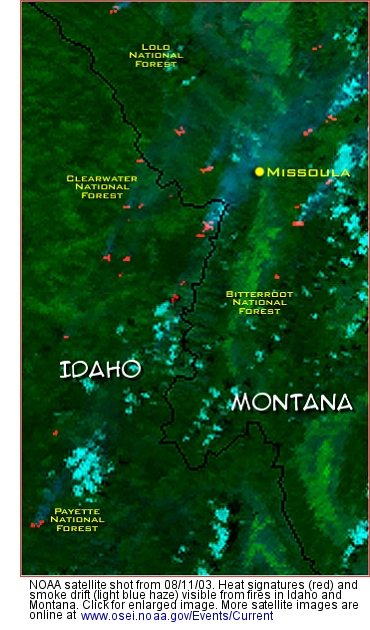 "There are fires everywhere," said Lolo Forest supervisor Debbie Austin. "There are fires everywhere," said Lolo Forest supervisor Debbie Austin.
The Missoulian reported that crews on Sunday were pulled off fires because of the extreme fire behavior -- huge crowning runs and flying embers spotting miles out in front of the main fires. One fire on the Clearwater in Idaho was throwing firebrands three miles ahead of itself.
"Just before things got too scary, we pulled everyone off every fire," said John Huston, the unit fire forester for the Montana Department of Natural Resources. "We had a red flag warning and it proved itself true. With the sheer number of fires and the smoke and haze, we don't even know what all we're working with." Plumes were visible in every direction from Missoula, and fires were on the run in Rock Creek, Schwartz Creek, the Potomac area and Wallace Creek, Boles Meadow, the Rattlesnake Wilderness, Fish Creek and Howard Creek. The Missoula Ranger District itself was working 40 fires.
The Billings Gazette reported that erratic winds blew a fire near Big Timber to 30,000 acres yesterday. The Hobble Fire was estimated at 10,000 acres late Saturday night, but ballooned on Sunday; 50 homes have been evacuated and remain threatened. Gray's Type 2 team has been assigned to the fire and will take over today. Don Barry, intel officer with Billings Dispatch, said two outbuildings were destroyed Saturday, and two more on Sunday. The fire ran for about two miles late Saturday night before settling back down around 3 a.m.
"It's beginning to turn into a real mess," said Barry.
Mike Johnson, a meteorologist for the National Weather Service in Missoula, said more of the same is expected. "Basically, it's going to be dry and windy, with temperatures in the 90s," he said. "And chances for isolated dry thunderstorms remain high." A red flag warning is posted for Missoula and surrounding areas through Monday evening.
Greg Greenhoe's Area Command Team is managing the Fish Creek, Cooney Ridge, Bowles Meadow, North Howard, Cherry Creek, and Gold 1 incidents on the Lolo National Forest, Bitterroot National Forest and the Southwest Land Office, Department of Natural Resources and Conservation. Rex Mann's Area Command Team is assigned to the Wedge Canyon, Robert, Trapper Creek Complex, Little Salmon Creek Complex, and Ross Creek fires on the Flathead and Kootenai National Forests and Glacier National Park.
|
NORTHERN ROCKIES REGION FIRES |
|
FIRE |
STATE |
ACRES |
CONTAINMENT |
| CHERRY CREEK | MT | 2000 | 0 |
|
BEAVER LAKE | ID | 2000 | 0 |
|
FISH CREEK | MT | 1000 | 0 |
|
HOBBLE | MT | 10,000 | 0 |
|
GOLD 1 | MT | 300 | 0 |
|
WEDGE CANYON | MT | 25,801 | 70 |
|
ROBERT | MT | 24400 | 58 |
|
TRAPPER CREEK | MT | 20522 | 60 |
|
SLIMS | ID | 9700 | 55 |
|
PIONEER LAKE | MT | 128 | 20 |
|
CLEAR/NEZ COMPLEX | ID | 125 | NR
|
| CRAZY HORSE | MT | 750 | 0
|
| LANDE | MT | 1100 | 80
|
| FRANK - WFU | WY | 600 | NR
|
| BLACKWALL | MT | 4515 | 95
|
| BIG CREEK | MT | 1339 | 90
|
| LITTLE SALMON | MT | 14345 | N/A
|
| NR = Not reported. WFU = Wildland fire use |

BEAR STARTED ALBERTA FIREJULY 16 -- SLAVE LAKE, ALBERTA, CANADA: A wildfire that could have cut power to not only the Mitsue Industrial Park east of Slave Lake, but also to Nipisi oilfields, was ignited by a bear. Atco Electric employee Danny Schmode said a bear climbing a power pole started the fire Wednesday afternoon.
The bear died and dropped to the ground when it touched the powerline, which started line insulators "bouncing." The two powerlines whipped around till they touched, according to the Lakeside Leader, creating a fireball that dropped into the dry fuels below; winds then drove the fire into black spruce.
"It's a major transmission line," said Schmode. "It was lucky that crews acted so quickly."
Doug Maurice, a ChevronTexaco operator, was driving down the industrial park road as the bear was shinnying up the power pole. "He got fried," said Maurice, "then we saw the torch."
He said the fire's speed was amazing. "A fire extinguisher wouldn't have had a chance."
Trina Torgerson was traveling down the same stretch of highway when the powerlines began jumping, and said she, too, saw the lines explode. She said the fire was crowning within minutes, and then it took off into the spruce stand. The province's helitack crews were en route minutes later, and three CL-215 airtankers were dispatched from Slave Lake's tanker base. A second group of three tankers was ordered from Lac La Biche, and a B-26 tanker was also dispatched from Slave Lake. It was diverted to a fire in the High Level forest before it could make its first drops. Crews limited the fire's spread to 15 acres and contained it two days later.

WELDING ARC IGNITED NEVADA FIREAUGUST 08 -- JIGGS, NV: A wildland fire that burned 150 acres and threatened one home northeast of Jiggs was ignited accidentally by an Elko company drilling a well, according to a report by the Las Vegas Sun. Employees of Hackworth Drilling were welding during a well-drilling operation, according to Elko Fire Marshal Dave Greenan. "They took preventive measures while they were welding," he said, "but this happened outside their preventive measures. The employees did everything they could to suppress it, but with the winds, they couldn't."
Mike McCarty, FMO for the Nevada Division of Forestry, said fire crews had the fire knocked down in a couple of hours. "We do want to commend everyone for the job they did," McCarty said. "They worked in red flag conditions, which is potentially the most severe fire conditions and behavior due to high wind."
Several aircraft were called in, including two SEATs from Wells, two heavy airtankers, and one air attack plane.

BOOK REVIEW: FIRE AND ASHESJUNE 18: John Maclean's done it again, only this time he's done it better. His first book, FIRE ON THE MOUNTAIN, was and still is a popular book with wildland firefighters. This one, though, will be a must-own for the summer army of boots-and-nomex firefighters -- and will surely be assigned as mandatory reading in many a fire training course.
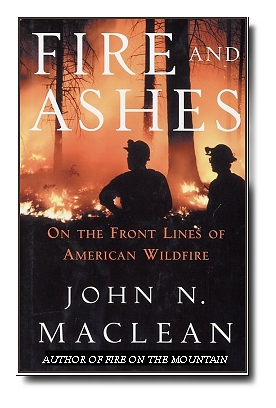 The collection of stories in FIRE AND ASHES proves up both Maclean's dogged pursuit of history and his determined focus on accuracy that comes from 30 years of journalism experience. Covering many thousands of miles, dozens of interviews, and painstaking attention to detail in his writing, Maclean has crafted a book that puts his readers out on the fireline. The collection of stories in FIRE AND ASHES proves up both Maclean's dogged pursuit of history and his determined focus on accuracy that comes from 30 years of journalism experience. Covering many thousands of miles, dozens of interviews, and painstaking attention to detail in his writing, Maclean has crafted a book that puts his readers out on the fireline.
Unlike many writers who try writing about wildfire, Maclean makes no lame allowances for readers who might not be familiar with the language and culture of the firefighter. He just explains it for them.
His recounting of the 1999 Sadler incident -- in retrospect a problematic compilation of small "oops" decisions that resulted in near-disaster -- is a chilling read when one considers how close it came to being a disaster like South Canyon. His "Short History of Wildland Fire" and glossary of fire terms will prove a useful go-to resource for firefighters -- structural and wildland both -- and for anyone curious enough to read about or write about fire.
It's Maclean's reconstruction of the 1953 Rattlesnake Fire, though, that stands as the highlight of the book. It's a can't-put-down story that's finally been accurately researched and told (and illustrated), about a fire that's been a benchmark for safety lessons and fire behavior training for 50 years. Young men and women in fire camps across the West -- and the older ones too -- will be packing this book along in their red bags this summer, and well they should.
| 
 The collection of stories in FIRE AND ASHES proves up both Maclean's dogged pursuit of history and his determined focus on accuracy that comes from 30 years of journalism experience. Covering many thousands of miles, dozens of interviews, and painstaking attention to detail in his writing, Maclean has crafted a book that puts his readers out on the fireline.
The collection of stories in FIRE AND ASHES proves up both Maclean's dogged pursuit of history and his determined focus on accuracy that comes from 30 years of journalism experience. Covering many thousands of miles, dozens of interviews, and painstaking attention to detail in his writing, Maclean has crafted a book that puts his readers out on the fireline.





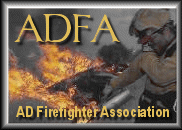




 Morcom's Type 2 team is headquartered at the Joseph Rodeo Grounds, with 11 crews, five engines, five helicopters, six water tenders, and a total of 430 personnel. The complex includes the Grouse Creek, Haas Ridge, Butcherknife, and Two Corral fires.
Morcom's Type 2 team is headquartered at the Joseph Rodeo Grounds, with 11 crews, five engines, five helicopters, six water tenders, and a total of 430 personnel. The complex includes the Grouse Creek, Haas Ridge, Butcherknife, and Two Corral fires.
 A Washington incident management team is assigned to the fire, which is burning in heavy timber just east of Danville. The fire is less than a mile from the Canadian border and headed north; a contingency line is being built on the Canadian side, and the British Columbia Forest Service is helping to put in a helicopter base in Grand Forks, about five miles north of the fire.
A Washington incident management team is assigned to the fire, which is burning in heavy timber just east of Danville. The fire is less than a mile from the Canadian border and headed north; a contingency line is being built on the Canadian side, and the British Columbia Forest Service is helping to put in a helicopter base in Grand Forks, about five miles north of the fire.



